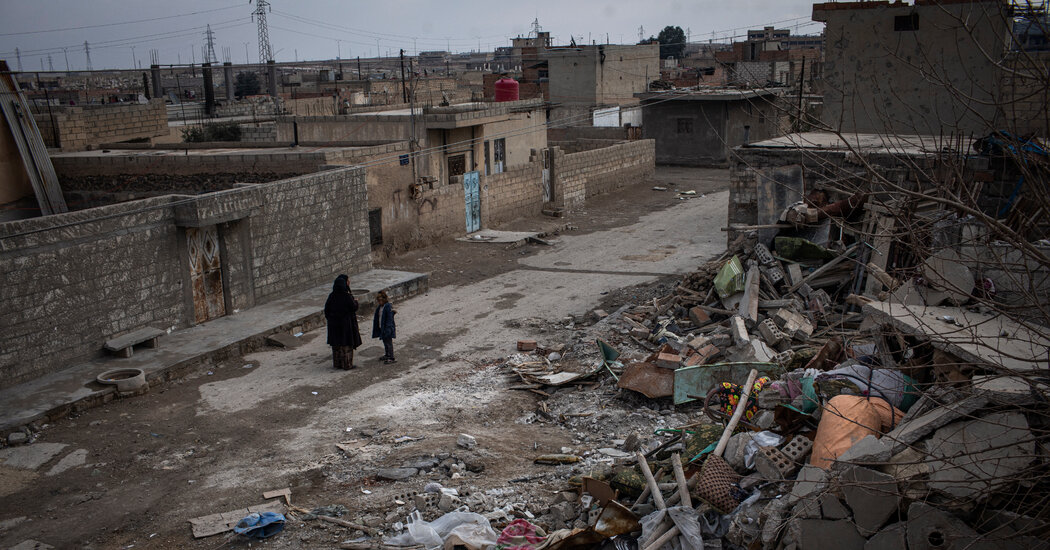UNICEF was given the first glimpse of teenage detainees at a prison attacked by ISIS two weeks ago in northeastern Syria.
QAMISHLI, Syria — Child detainees at a prison in northeast Syria that was attacked by ISIS two weeks ago are injured, hungry and thirsty, according to the first international aid worker to see them since the siege.
“They just managed to say a few words: that they are hungry, they need water, they need medical care,” said the official, Bo Viktor Nylund, UNICEF Syria’s representative, who visited the Sinaa prison on Saturday. Prison authorities allowed him to view the children through small, barred windows in the steel cell doors but not to speak with them.
The makeshift prison, in the city of Hasaka, that was attacked on Jan. 20 by ISIS suicide bombers and gunmen held about 4,000 suspected ISIS fighters and about 700 teenagers. Fears over the teenagers’ safety grew after the American-backed Syrian Democratic Forces, which is in charge of this breakaway region of Syria, said that ISIS gunmen had used some of them as human shields during the attack.
Hundreds of inmates were killed over 10 days as the Syrian Democratic Forces and American ground forces fought to retake control of the prison from the terrorist group.
The S.D.F. said it lost 40 fighters and 77 guards and other prison workers. But it has not revealed details of the teenagers’ fates and has barred access to journalists — and, until Saturday, to aid organizations, like UNICEF and the International Committee of the Red Cross, which is normally the first to visit detainees.
A photograph provided by UNICEF to The New York Times showed the teenagers, their identities shielded, sitting barefoot on a broken concrete and dirt floor with thin mattresses lined end to end. Sunlight through high windows illuminated what looked like blackened walls. Some of the boys had blankets wrapped around their shoulders.
“We saw hundreds of boys,” Mr. Nylund told The Times on Sunday. “Quite skinny and in need of a lot of services, including medical support.”
He said that S.D.F. officials told him on Saturday that there were 700 detained minors — the same number they gave before the prison siege — and that he was shown “six or seven” cells, each with about 30 children. Mr. Nylund estimated that the youngest prisoner he saw was about 15.
He said that the smell of smoke still hung in the air and that the prison’s walls were scorched, but that “they managed to get the basics in place,” he said, referring to the blankets and mattresses.
“But it’s been a war zone,” Mr. Nylund added.
The teenagers have been held in the makeshift prison since they were separated from women and younger children after ISIS fell in 2019, and none have been before a judge since being detained.
The S.D.F. has said that the boys’ ties to the Islamic State make them dangerous, and that some of the older ones have been trained to fight, while human rights organizations consider them victims, children taken to the Islamic State through no choice of their own.
In the past three years, few aid organizations have been given even a glimpse of the teenagers, as the S.D.F. has restricted access to them.
“We have been working on getting access for the last year plus,” Mr. Nylund said of the Sinaa prison. “We have not spoken in detail to a single one of them.”
Last week, The Times saw two bodies that appeared to be those of teenagers among other bodies found in the neighborhood around the prison where residents reported seeing ISIS attackers during the siege. Prison clothing was also among the remains. About 200 ISIS fighters had attacked the prison to try to break out detained comrades, and it was not clear whether the boys had escaped with adult prisoners or been taken hostage by them.
Mazlum Kobani, the commander of the Kurdish-led Syrian Democratic Forces, told The Times that a “very small number” of the teenagers had been killed in the operation to retake the prison and to arrest ISIS fighters.
Human Rights Watch said that two detainees had told it that they saw children killed during the fighting for the prison, and that another detainee described how a child bled to death in his arms.
An S.D.F. official told The Times last week that the boys had been moved from the Sinaa prison to safety in a newer facility, but Mr. Nylund, the UNICEF official, said he saw them in the same place where they were held before the attack.
“We have no information,” an S.D.F. spokesman, Ferhad Shami, said on Sunday when asked about the discrepancy.
Mr. Nylund said UNICEF hoped to first provide help to the youngest prisoners and to those who were sick or wounded. After that, he said, the U.N. organization will try to establish case files for the children, with the aim of repatriating foreigners to third countries. Most countries have refused to repatriate prisoners or families in detention camps from this region of Syria.
“We will do it on the condition that we have continuous access because unless we do, we are being used,” Mr. Nylund said in an unusually blunt comment about the lack of access offered by officials eager to show they are working with international organizations, but less willing to let them in.
“Let’s see that there’s an actual willingness to take this to the next level because, to date, we have not seen that this has actually happened,” he said.
UNICEF said in a statement announcing the visit that the children should be transferred to the care of child protection agencies and that foreigners should be repatriated to their home countries.
“Children associated with and recruited by armed groups should always be treated as victims of conflict,” it said.


























